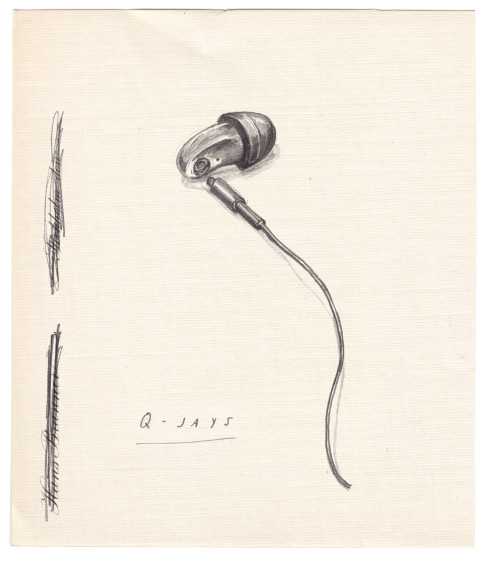
TLM10: HARPER REED
It’s difficult to look at Harper Reed’s work without looking at the dialogue surrounding it, which is an unfortunate side effect of its impact. The former CTO of Obama for America 2012, Reed is an overtly-contemporary figure in a disarmingly slowly-moving field, and his youthful understanding of the interconnectedness of digital life is often cited when explaining the underpinnings of Obama’s electoral success. The gauges, mohawk, and handlebar mustache simply add to the myth, that of the hacker-cum-reformist who turned the campaign world upside down with a few lines of code.
Reed himself doesn’t subscribe to that myth. Technology, he points out, is inescapable—it is our world in that it permeates nearly everything we do. In 2012, he and his team were able to secure the presidency by harnessing this ubiquity to empower traditional campaign outlets that had for so long failed to secure the youth vote. But where the world sees a solely digital campaign, quick to follow a narrative set forth by Reed’s past—hacker, death-metal fan, professional yo-yo practitioner, founder of Jugglers Against Homophobia—Reed sees a traditional grassroots effort. “Together, we won the election,” Reed says. “But all the volunteers, all the people that really did all the hard work—getting people out to vote, making sure people stayed in line—all of that was really where the program was the strongest.”
“I talk about the force multiplier a lot,” Reed continues. “It’s what technology should be, and that’s a great example of what that is: making sure that we’re making technology a tool to help make things easier.” Reed arrived in Chicago in 2001, fresh out of Cornell College, and quickly embarked on projects that tested this theory, each with varying levels of seriousness. He sold plots of land on the sun, for example, through WeOwnTheSun.com, aggregated information on government contracts through CityPayments.org, and hacked a Chicago Transit Authority app in order to make its data public. He ultimately took a position at Threadless, where, as CTO, he oversaw a multi-million-dollar brand that selects user-submitted clothing designs based on the votes of other users. See the trend? Technology, which took shape through Reed by way of complex code, was a means of crowd-sourcing information and using it to benefit the public. The success was expected. The campaign wasn’t. “It wasn’t a surprise that the technology worked out,” he explains. “But then the President knocks on your door.”
“It was pretty abrupt of a transition. Campaigns, especially at the presidential level, you don’t have a lot of opportunity to fuck around,” Reed continues. “It’s much more deliberate and methodical.” Narwhal, the golden child of the Obama campaign, was the product of this new level of focus—a vast network that connected data from the campaign’s key social and nonsocial outlets in real time. This mass compiling of information defined targeted voters, adding a new level of depth to their digital profiles, and allowed volunteers tasked with targeting these potential supporters the ability to do so more effectively than ever before. Alongside Joe Rospars, chief digital strategist; Michael Slaby, chief integration and innovation officer; Dan Wagner, chief analytics officer; and Jeremy Bird, national field director; Reed built the network on a limitless scale with a hundred engineers and a million other volunteers on foot. “This is basically us empowering you, the volunteer, to do what amounts to our job, but it’s also almost the definition of grassroots,” Reed says. “It’s taking grassroots and putting it on the Internet.”
That’s the simplified version. Making accessible the inaccessible is Reed’s speciality, and his impact on the ground was enough to turn heads on both sides of the political line. At thirty-four years old, he still embodies the startup culture that raised him: quick-witted and mentally agile, æsthetically unrestrained, amiable but confident. More importantly, he understands the inner workings of a company that must be able to deconstruct itself at any moment and be willing to discard the pieces that drag. But at the Obama camp, stationed in Chicago, it was also a numbers game. With his hands off the software, Reed was put in the position of masking a startup in the shell of a business; where the former might reinvent itself without end, testing and rebuilding on a loop, an election needs a project that adjusts in the background while operating at full speed. “Hilariously, I was basically a bureaucrat, but it wasn’t bad,” he says of his position inside headquarters. “I was banished from the code.”
From the top, it was a matter of balancing startup flexibility with near-perfect execution, which “creates a pretty good beast, where the campaign world learns how to be more iterative, and then the startup world learns a little more about how to have a very serious program,” Reed continues. He began in May 2011—a solid eighteen months before the election. “I think that’s what the key is: early on, the campaign made the choice to engage in technology and the Internet,” says Reed, who was handed the position by Slaby, the CTO of Obama’s 2008 campaign. “In a lot of ways, he was the Billy Beane—if we’re talking about Moneyball—of the campaign, saying that they had to do things differently. And the campaign really invested in that. The sad part about this is, according to the movie, I was Google Boy.” While Slaby recognized the value of data, that is, Reed had the technical know-how to gather it on a grand scale. “He had to hire someone that really embodied technology, and they hired me very, very early, and that allowed the campaign to have this technology foundation,” Reed says. “We were able to do all of this stuff that no one had ever done before.”
The transition from Slaby to Reed followed a trajectory outlined by a world changing more rapidly than voters realized. In 2008, Facebook and Twitter were campaign newcomers, and the youthful sheen of Obama’s message was reinforced—and widely reported as such—by a commitment to social media. In retrospect, it was largely
surface-level, and both services have since become a prerequisite for public presentation. 2012 required an understanding that, in some ways, there’s an underside to these services that’s significantly more valuable. Beneath our walls and status updates and images, we’re providing a previously-unavailable amount of data on our social leanings, political beliefs, names, ages, habits, and so on, and we’re doing so voluntarily. Between 2008 and 2012, political camps learned that the real value in these networks—beyond the overt spreading of information they allowed—was the passageways that existed beneath them, these channels of data. Reed’s appointment wasn’t a half-hearted attempt at a progressive mentality, nor a commitment to social media’s promotional core. “It was much more prolific,” he says of the use of technology.
Leading a team of engineers from Facebook, Twitter, Google, and Threadless, Reed had to soften a group mentality that saw redefinition—building and breaking, building and breaking—as a means to an always-temporary end. But they had to build something nimble that could flex in a unique direction for each of the million volunteers, who operated not unlike a social network of their own. “You help us convince people because we give you the tools,” Reed says. “Some of the best social networks out there, all they’ve done is create a world and then given users the tools to curate that world.” Volunteers, operating like users, moved across the United States as though it were a platform like Facebook, disseminating information to attract more users, who continued the cycle. In 2008, these volunteers were social network fans of Barack Obama; in 2012, they were very much the network themselves.
“You say, for instance, ‘I’m a veteran.’ So from there, we can say, ‘You’re a veteran, and we know that veterans talking to veterans works better, so we can make sure that the next person you’re talking to is a veteran,’” Reed explains. “Having it all in one place, we know more about who you are as a person, not just you as an email address.” On the ground, a canvasser moving door-to-door could pull information about his target—as well as information about how to most effectively address that target. He could then report back on the success of his technique, allowing the campaign to adjust its approach for other canvassers. The interconnectedness spanned across the Internet and then offline entirely, and the tools created— the Call Tool, the PeopleMatcher, Dashboard, and the Facebook Blaster, among others—used the digital world to enable supporters in the real world. “When I say the Internet, it’s not just social,” says Reed. “We tried to have a presence that was genuine on every website. That really kind of showed us what or how things work.” And like a startup—albeit with less frequency—they’d take the success of their products and build on top of them, creating new versions for their users to better spread Obama’s message. “So we reach out to people who are using our software and make sure it works,” Reed says. “That’s something you do at a startup every day.”
What’s changed, of course, beyond a landscape in which America’s first black president achieves a second term, is the process that got him there. This extends well beyond the type of transformation that took place when radio and television introduced new venues for advertising. Technology—not just a mere matter of social networks, as Reed points out—has permeated our lives minutely, reshaping the way we consume information just as it reshapes the way we share it with one another. And as obvious as that may seem, not everyone, including Mitt Romney’s team, has been able to figure out what to do with it. Orca, the Republican response to Narwhal, turned out to be a mere glimmer of its rival— an app that simply allowed field workers to report voter turnout on election day, and which crashed on the only day it was intended to work. Ultimately, Orca, which derived its name from the only known predator of the narwhal, proved to be a fragment of its competition, the size of a cog in Obama’s vast machine and a consequence of poor perspective in a well-funded rival camp.
According to Reed, whose earned confidence seems often misconceived as hubris, the advanced level of his team’s work is today’s standard fare. “What we saw is what is the new normal,” he suggests. “If I were going to invest today to make sure 2016 is solid, I would be investing in mathematicians, statisticians, and the people that do all of the analytics and the modeling. Technology I think is a given, but I don’t think people are really thinking about that.” His success thus far provides that type of foresight. What it didn’t provide was a prediction of the actual experience of being in the Obama camp as the changes were taking place, when the processes that seemed so advanced in 2008—the Facebook pages, the YouTube channels—were being tied beneath to something much greater. “I wasn’t necessarily surprised by what happened, because I’m obviously very political,” he says of his hiring. “I think what I was surprised by was just how awesome it was and the team that we were able to get and all of the stuff, how it turned out.”
Even more complicated still is post-election life, transitioning from the weightless world of startups to a campaign and then back again. “At Threadless, the worst thing that would happen to someone is that we’d ruin someone’s gift-giving. That was literally the worst thing that would happen,” Reed says, laughing. “But when the worst thing you can do is give data that inadvertently causes us to lose the election, that’s different.” The result is fresh enough, the response still wide enough, that Reed’s tone seems tinged with a bit of nostalgia, as though eighteen months passed in a day and he’s still bouncing back. “It was the hardest job I’ve ever had. It was incredibly frustrating, and it was incredibly difficult, but it was also awesome,” he reflects. “With that said, what’s next? I don’t know, right? How could I possibly have something that’s better than this?”













